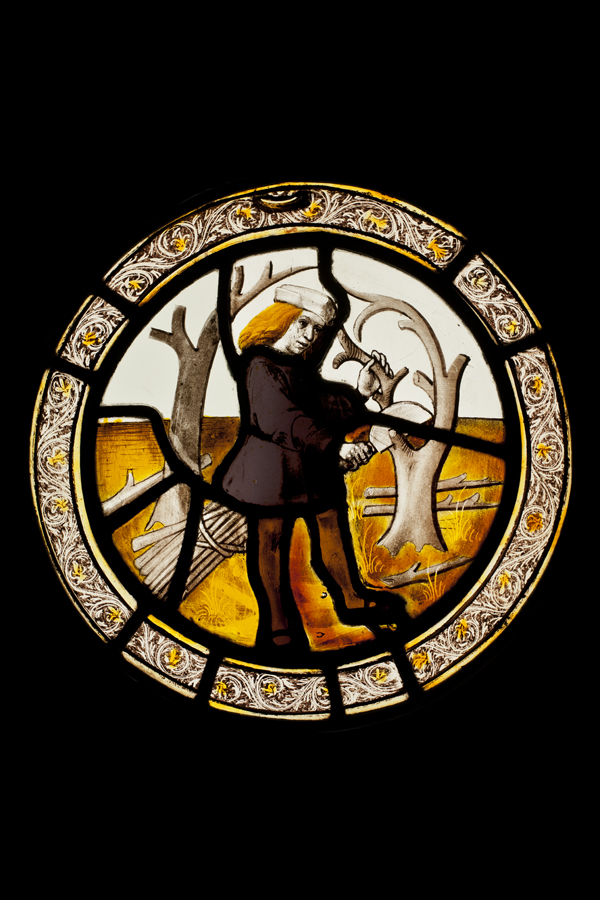roundel
Accession Number NWHCM : 2012.120
Description
roundel from set depicting Labours of the Months; peasant pruning trees, may represent month of February
Read Moreroundel
These very rare stained glass roundels survive from an original set of twelve, depicting the Labours of the Months. They are likely to have been made originally in about 1525 for the house of Thomas Pykerell (d.1545), a merchant, Sheriff and Mayor in Norwich. His house still stands in Rosemary Lane, although the roundels were moved in the mid-19th century when the house became a pub. Eight of the roundels survive and four are in the collection of Norfolk Museums Service.
The theme of ‘Labours’ was very popular both in Britain and in mainland Europe during the medieval period. Sets of Labours were made in a variety of media including manuscript illumination, carving, painting, and stained glass for both religious and domestic settings. The scenes usually show the rural tasks associated with different months of the year, such as harvesting fruit, sowing seed, pruning trees and hunting, however some sets also include scenes of feasting and courtly activities. In Britain, their popularity peaked during the second half of the fifteenth century, although no complete set survives in glass.
These roundels have been composed with the highest artistic and technical skill. The faces are rendered with great character, and the figures show a strong Flemish influence in their high degree of naturalism. During the 15th century, Netherlandish art was known for its accurate representation of reality achieved through very precise observation and close attention to detail. Stained glass makers from the Low Countries are known to have worked in Norwich. The strongest candidate for the maker of these roundels is John Wattok, who was of Dutch origin and active during the period c.1495-1540. His workshop was near Rosemary Lane.
In this panel a labourer prunes trees with what appears to be a bowsaw. He has made a bundle of the long, straight off-cuts - perhaps to be used for fencing or firewood. It is not always clear to which month the tasks correspond, but here the bare trees and pale colours of the landscape suggest very early spring. The month is probably intended to represent February. Winter pruning of trees encourages vigorous growth in the spring, while summer pruning promotes good flower and fruit formation. The labourer appears to be sawing off most of the branches down to the tree trunk, which suggests he may be pollarding the trees to encourage long straight new shoots to grow – an activity undertaken in very early spring. The long straight new branches could then be used for a variety of purposes including fencing or basketwork, depending on what type of trees these are.
The arched shapes of the trees fit elegantly into the round composition and echo the scrolling pattern of the leaves in the circular border. The restrained colour palette of yellow, blue and brown ties this scene visually to the others in the series and gives it a sense of graceful simplicity.
An early 18th-century description of Pykerell’s house on Rosemary Lane in Norwich records the presence of stained glass roundels of the twelve months of the year in one of the windows. So while it cannot be proved beyond doubt that these roundels were made for Pykerell’s house by Wattok, we know that a set of Labours of the Months definitely existed there. Stained glass was expensive at the time and a luxury in a domestic setting. Pykerell, a wealthy merchant, was elected mayor of Norwich in 1525, around the time he updated his house and these roundels were made. It is possible that Pykerell commissioned these stained glass roundels to show off his wealth and new social status as mayor.
By 1860, Pykerell’s house had been converted into a pub and the roundels had been removed. A set of eight roundels were installed at Brandiston Hall probably in around 1875, remaining there until 1985, although it is not certain whether these came from or via nearby Marsham Church. Four of the twelve roundels were lost and never reappeared – perhaps they were broken during removal. Pykerell’s house was bombed during the Second World War but has since been restored and is now a home again. Although the medieval-style great hall was divided laterally by the addition of a floor in the 17th century, it is still possible to see the top half of the large original windows where the glass roundels would once have been placed.






